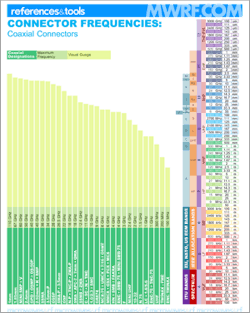Connector Frequencies: Coaxial
By: Jean-Jacques DeLisle
[Register or Login at the bottom of this page to gain access to this download] Coaxial cable connectors are a fundamental component for interfacing with RF devices up to hundreds of gigahertz. The frequency handling capability of coaxial connectors is based upon the dimensions of the inner and outer conductors, as well as the quality of precision in which the parts of the coaxial connector are constructed. Coaxial connectors are generally designed with either 50 or 75 ohms of impedance. The impedance of the coaxial connector is dictated by the dielectric material between the inner and outer conductors and their ratio. Conductors for coaxial connectors also respond differently at various frequencies. Examples include the magnetic properties of nickel and steel limiting the frequency range of operation. Some conductors are coated with other metals to enhance the performance of the connector material. These performance enhancements may not be designed for improving the frequency performance, and could have adverse effects of the connector’s frequency response.
All of these factors and more come into play when defining the maximum frequency capability of a connector. The major limiting factor is size. The larger the size of the coaxial connector the lower maximum frequency it can transport a transverse electromagnetic (TEM) wave. If a frequency greater than the maximum frequency of TEM operation is induced on a coaxial connector a waveguide-like response will occur and the transmission capabilities of the line will degrade. The smaller the coaxial connector the less power the connector can handle, so there is a tangible trade-off with power and frequency when using coaxial connectors.
The reference “Coaxial Connector Frequencies” shows many of the most popular sizes and styles of coaxial connectors and what their theoretical maximum frequency of operation is in a side by side comparison. Several common band and allocation designations and their ranges are provided for a side by side comparison as well. As the chart is produced spatially accurate to the frequency range, a straight edge can be slide across a printed sheet to visuals which connectors can operate in which bands and designations.
For a side-by-side comparison of coaxial and rectangular waveguide connectors, see “Coaxial & Waveguide Connector Frequencies.”

